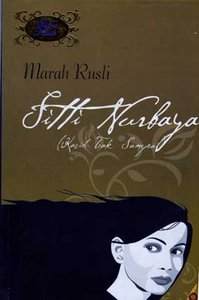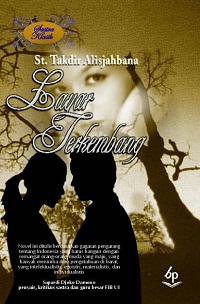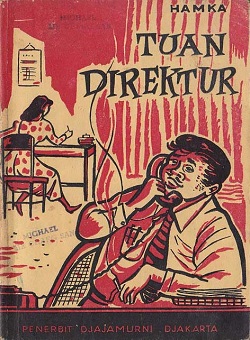Related Research Articles

Idrus was an Indonesian author best known for his realistic short stories and novels. He is known as the representative of the prose of the '45 generation of Indonesian literature.

Salah Asuhan is an Indonesian novel by Abdul Muis originally published in 1928 by Balai Pustaka. It is widely considered one of the best examples of early modern Indonesian literature.
Balai Pustaka is the state-owned publisher of Indonesia and publisher of major pieces of Indonesian literature such as Salah Asuhan, Sitti Nurbaya and Layar Terkembang. Its head office is in Jakarta.

Azab dan Sengsara is a 1920 novel written by Merari Siregar and published by Balai Pustaka, Indonesia's major publisher at that time. It tells the story of two lovers, Amiruddin and Mariamin, who are unable to marry and eventually become miserable. It is generally considered the first modern Indonesian novel.

Sitti Nurbaya: Kasih Tak Sampai is an Indonesian novel by Marah Rusli. It was published by Balai Pustaka, the state-owned publisher and literary bureau of the Dutch East Indies, in 1922. The author was influenced by the cultures of the west Sumatran Minangkabau and the Dutch colonials, who had controlled Indonesia in various forms since the 17th century. Another influence may have been a negative experience within the author's family; after he had chosen a Sundanese woman to be his wife, Rusli's family brought him back to Padang and forced him to marry a Minangkabau woman chosen for him.

Layar Terkembang is an Indonesian novel by Sutan Takdir Alisjahbana. Published in 1936 or 1937 by Balai Pustaka, it tells the story of two sisters and their relationship with a medical student. It has been noted as emphasizing the need for Indonesians to adopt Western values in order to modernize the country.

Poedjangga Baroe was an Indonesian avant-garde literary magazine published from July 1933 to February 1942. It was founded by Armijn Pane, Amir Hamzah, and Sutan Takdir Alisjahbana.

Bakri Siregar was an Indonesian socialist literary critic and writer.
Darah Muda is a 1927 novel written by Indonesian writer Djamaluddin Adinegoro and published by Balai Pustaka. It is one of few Indonesian novels from the period in which the protagonists succeed in love.

Marco Kartodikromo, also known by his pen name Mas Marco, was an Indonesian journalist and writer.

Dian jang Ta' Koendjoeng Padam is a 1932 novel by Sutan Takdir Alisjahbana. It was published by Balai Pustaka.
Asmara Djaja is a 1928 novel written by Indonesian writer Djamaluddin Adinegoro and published by Balai Pustaka. It is one of few Indonesian novels from the period in which the protagonists succeed in love.
"Soerabaja" is a work of fiction by Indonesian writer Idrus variously described as a novel, novelette, and long short story. It was published in 1946 or 1947.

Di Bawah Lindungan Ka'bah is the 1938 debut novel of the Indonesian author Haji Abdul Malik Karim Amrullah (1908–1981). Written while the author worked in Medan as the editor of an Islamic weekly magazine, the novel follows the doomed romance of a young Minang couple from different social backgrounds. Generally praised for its simple yet eloquent diction, the novel has been twice adapted into film, first in 1977 and then in 2011.

Tenggelamnja Kapal van der Wijck is an Indonesian serial and later novel by Haji Abdul Malik Karim Amrullah published in 1938. It follows the failed love between Zainuddin, a mixed-race man, and Hayati, a pure Minang woman.

Tuan Direktur is a 1939 novel by the Indonesian Muslim cleric and writer Haji Abdul Malik Karim Amrullah (Hamka). Originally published as a serial in Hamka's newspaper Pedoman Masjarakat, it follows a man from Banjarmasin who goes to Surabaya, becomes rich, but ultimately is driven to insanity. The novel has been seen as a critique of materialism, arrogance, and superstition.

Sariamin Ismail was the first female Indonesian novelist to be published in the Dutch East Indies. A teacher by trade, by the 1930s she had begun writing in newspapers; she published her first novel, Kalau Tak Untung, in 1933. She published two novels and several poetry anthologies afterwards, while continuing to teach and – between 1947 and 1949 – serving as a member of the regional representative body in Riau. Her literary works often dealt with star-crossed lovers and the role of fate, while her editorials were staunchly anti-polygamy. She was one of only a handful of Indonesian women authors to be published at all during the colonial period, alongside Fatimah Hasan Delais, Saadah Alim, Soewarsih Djojopoespito and a few others.

Korrie Layun Rampan was an Indonesian novelist, short story writer, poet, literary critic, journalist, and politician.
Triyanto Triwikromo is an Indonesian writer born in Salatiga, Central Java.

Diah Hadaning was an Indonesian writer. Among friends she is known as Diha.
References
- ↑ Rampan, Korrie Layun (2000). Leksikon Sastra Indonesia[Lexicon of Indonesian Literature] (in Indonesian) (First ed.). Jakarta: Balai Pustaka. p. 437. ISBN 979-666-358-9.
- ↑ (in Indonesian) Siregar, Sori. Senja. Nusa Indah, 1979, Flores. Halaman sampul belakang.
- ↑ (in Indonesian) Siregar, Sori. Telepon. Balai Pustaka, 1982, Jakarta. Halaman sampul belakang.
- ↑ "ENSIKLOPEDIA TOKOH BATAK" (in Indonesian). 2009.
- ↑ "Cerpen Koran Minggu" (in Indonesian).
- ↑ "Archive Sori Siregar" (in Indonesian).
- ↑ "Ensiklopedi Jakarta Sori Siregar" (in Indonesian).